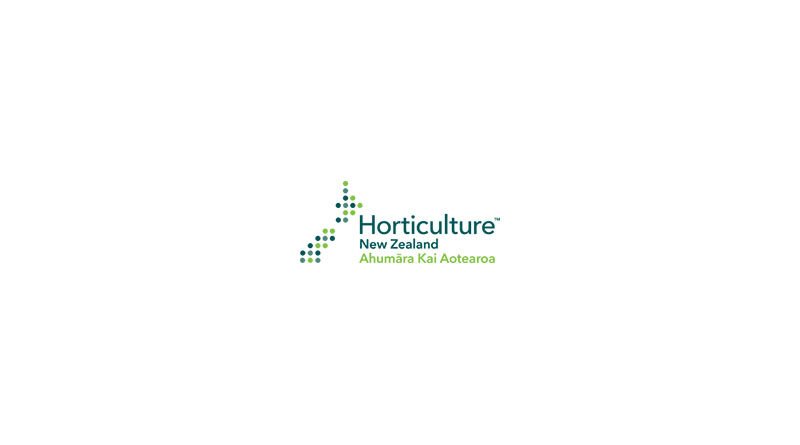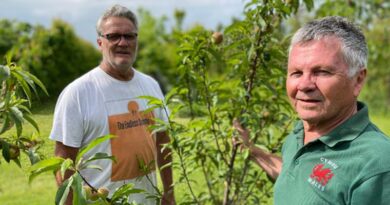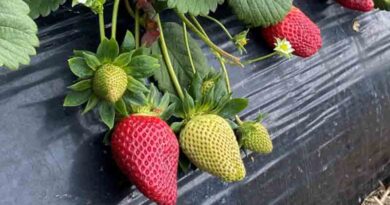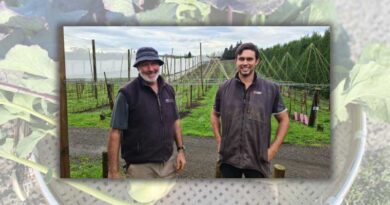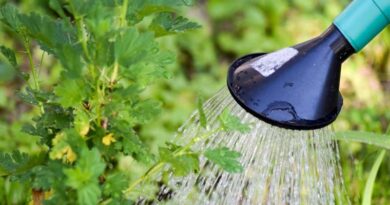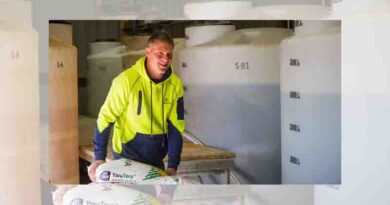Feijoa fever: A love of growing despite challenging times
12 October 2022, NZ: For most people, their sixties are the time to start thinking about retirement. But not Roger Matthews. With an orchard full of feijoas and other fruit to keep him busy, he scoffs at the idea. GEOFF LEWIS speaks to the Morrinsville resident on the art and challenges of feijoa growing.
Roger, 64, has spent most of his working life in local government all over the North Island often in senior management roles. He spent three years in business development at Unitech looking at ways to commercialise research.
That was until about six years ago when he bought a flat eight-hectare maize block not far from Morrinsville to convert into a commercial orchard.
“We couldn’t move on until the maize was cropped and what was left was basically bare earth,” Roger says.
Inside the gate of Pounamu Orchard are 150 macadamia trees planted in 2018, with gaps filled by chestnuts. The property has no bore and relies on rainwater. Three droughts knocked out some of the young trees, while others have struggled and haven’t got much further than their original planted size.
Further in is a small citrus planting that Roger has established “for fun,” featuring lemons, limes, mandarins and kaffir limes which are sold to local supermarkets.
A small mix of apples, both eating apples and for cider-making, are also planted on the property. A hybrid of Japanese and European chestnuts, figs, plums and avocados complete the eclectic orchard line-up.
Feijoas are Roger’s largest planting. Four years ago, he planted 1100 trees in three half-hectare blocks including the Kakariki, Anatoki, Wiki Tu, White Goose, Opal Star and Golden Goose feijoa varieties. White Goose is often used for making feijoa wine in New Zealand, whereas the thinner-skinned Golden Goose variety can be eaten whole – skin and all.
As feijoas are pollinated by birds, each row of trees has a bird-box on its leading post to facilitate pollination. Varieties are alternated to maximise pollination.
A feature of Roger’s feijoa plantation is that it is espaliered – that is, the branches of the feijoa trees are trained horizontally along wires. This style not only saves space but improves flowering and increases the ease of harvest. With a nod to health and safety it means that no ladders are required.
“The aim is to shape the branches to get the right pattern and allow for plenty of air movement,” Roger says.
Roger completes the pruning himself – two days in each row with a fearsome pair of battery-powered secateurs which will bisect Feijoa stems, No. 8 wire and fingers with equal ease – “the most dangerous thing in the orchard”, Roger says.
Annual production has risen to about 1.5 tonnes over three years, with the fruit going to market through MG Marketing.
“It’s a $100,000 investment,” Roger says. “We hope to break even in five years.”
Growing feijoas is not without its challenges though, with orchardists facing numerous hurdles of late.
Frans de Jong, from Southern Belle Orchard near Matamata which also grows feijoa, has been assisting Roger in developing solutions for the orchard to overcome issues such as a volatile shipping and operating environment.
“He’s Dutch, a scientist and very precise,” Roger says. “I have confidence in the way Frans does things like touch picking – touch picking for export gives extended shelf life.”
Airfreighting the fruit has all but come to an end, with costs five to six times greater due to disruptions caused by the Covid-19 pandemic.
“There’s very little hope we will get back into airfreight,” Roger says. “We did a trial to Singapore by sea, but timing is imperative. Even with the help of Southern Belle, it is difficult to get the quantity needed to fill a shipping container.”
To add to the complexities, Roger, who is also president of the New Zealand Feijoa Growers Association (NZFGA), says despite a free-trade agreement with China, feijoas aren’t on the list of produce covered by the agreement.
Getting on the list will cost $2m to $2.5m to go through the process to allow export.
Understandably, most of Roger’s feijoa production now goes into the domestic market.
“We try to get into the fresh fruit market early in the season where we can get $4 a kg. If the fruit goes to [a] processor it’s only $1.10 to $1.20 a kg.”
Most feijoa growers are in the warmer parts of the country with the largest around Gisborne. Northland growers have been struggling with guava moth for nearly 20 years, with the pest slowly moving south. It is now found in the Coromandel, but not yet the Waikato.
Similarly, the anthracnose fungal disease, which has devastated crops in Kerikeri, but hopefully this won’t travel south and infect fruit beyond the Kerikeri area.
The NZFGA in conjunction with Plant & Food Research and other partners, is taking part in two $300,000 research projects aimed at guava moth and anthracnose fungus. The projects are funded by the government’s Sustainable Farming Fund.
Also Read: Indian farmers are using less agrochemicals shows data for FY2021-22
(For Latest Agriculture News & Updates, follow Krishak Jagat on Google News)

